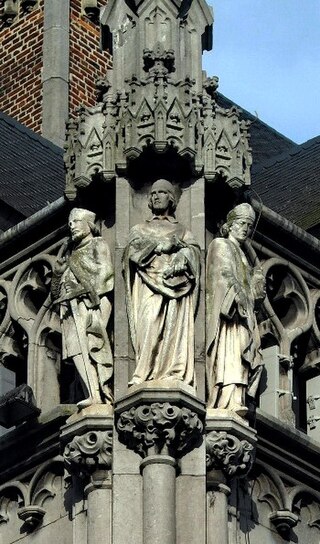Related Research Articles

Pope Sixtus II, also written as Pope Xystus II, was bishop of Rome from 31 August 257 until his death on 6 August 258. He was martyred along with seven deacons, including Lawrence of Rome, during the persecution of Christians by the Emperor Valerian.

Saints Faith, Hope and Charity, are a group of Christian martyred saints, venerated together with their mother, Sofiia ("Wisdom").

Theodora was a senatrix and serenissima vestaratrix of Rome. Theodora was married to Theophylact I, Count of Tusculum. The couple shared effective rulership of Rome between 905 and her death in 916.
D. Diogo Ortiz de Villegas "Calzadilla" was a Castilian priest, theologian and astronomer at the service of the Portuguese monarchs. He was born in Calzadilla, Castile, ca. 1457 and died in Almeirim (Portugal), in 1519.
Alban of Mainz was a Catholic priest, missionary, and martyr in the Late Roman Empire. He is venerated as Saint Alban of Mainz in the Catholic Church, not to be confused with Saint Alban of Verulamium.

Simon de Cramaud was a Catholic bishop, titular Latin Patriarch of Alexandria, and cardinal during the Great Western Schism of the fourteenth and fifteenth centuries.

Saint Liberalis of Treviso is a saint of the 4th century. Tradition states that he was a priest who opposed Arianism and that he was persecuted at Ancona.

The Institute of the Mother of Good Counsel is a sedeprivationist traditionalist Catholic religious congregation based in Italy.

Saint Trudpert was a missionary in Germany in the seventh century. He is generally called a Celtic monk from Ireland, but some consider him a German.

Viktor of Xanten was a 4th century martyr and saint recognized by the Roman Catholic Church and the Eastern Orthodox Church. Since the 12th century, his presumed bones have been kept in a shrine, which is embedded in the high altar of the Xanten Cathedral. His feast day is October 10.
Cuthbert Hamilton Turner (1860–1930) was an English ecclesiastical historian and Biblical scholar. He became Dean Ireland's Professor of the Exegesis of Holy Scripture in the University of Oxford in 1920.

Wazo of Liège was bishop of Liège from 1041 to 1048, and a significant educator and theologian. His life was chronicled by his contemporary Anselm of Liège.
Saint Edistus is venerated as a martyr and saint by the Roman Catholic and Eastern Orthodox churches. His legend states that he was martyred on the Via Laurentina and his passio places his martyrdom during the reign of Nero, on October 12, 60 AD.

Thiemo was Archbishop of Salzburg from 1090 until his death. He is venerated as a Christian martyr.

Eberigisil was Bishop of Cologne, being the fifth well-attested bishop, and the first with a Frankish name. Evergislu's tenure was marked by the unrest brought about by the migration of peoples, which dominated both city and country. Evergislus tried to build up religious life and ecclesiastical peace.

Quirinus of Neuss, sometimes called Quirinus of Rome is venerated as a martyr and saint of the Catholic and Eastern Orthodox churches. His cult was centered at Neuss in Germany, though he was a Roman martyr.

Saint Magnus of Anagni, also known as Magnus of Trani or Magnus of Fabrateria Vetus, is venerated as the patron saint of Anagni.

Werner of Oberwesel was a 16-year-old boy whose unexplained death was blamed on Jews, leading to revenge killings of Jews across Europe. He was venerated as a Christian saint, and his memorial day was 19 April.

Justin the Confessor was a Christian martyr in the Roman Empire. He is honoured as a saint by the Roman Catholic Church.

Aureus of Mainz is a Roman Catholic saint and the first named bishop of Mainz. His feast is on 16 June.
References
- 1 2 3 4 5 6 7 8 9 10 11 12 13 14 15 16 17 Bruno W. Häuptli (2003). "Theonistus". In Bautz, Traugott (ed.). Biographisch-Bibliographisches Kirchenlexikon (BBKL) (in German). Vol. 22. Nordhausen: Bautz. cols. 1344–1346. ISBN 3-88309-133-2.
- 1 2 San Teonesto (o Teonisto o Tonisto)
- ↑ Gregory of Tours, Glory of the Confessors. Translated by Raymond Van Dam (Liverpool University Press, 1988), 40n.
- ↑ Gregory of Tours, Glory of the Confessors. Translated by Raymond Van Dam (Liverpool University Press, 1988), 39.
- 1 2 William George Smith; Henry Wace, A Dictionary of Christian Biography, Literature, Sects and Doctrines (J. Murray, 1877), 70.
- ↑ San Teonesto
- ↑ San Liberale
- ↑ Owen Chadwick, The Popes and European Revolution (Oxford University Press, 1981), 586-7.